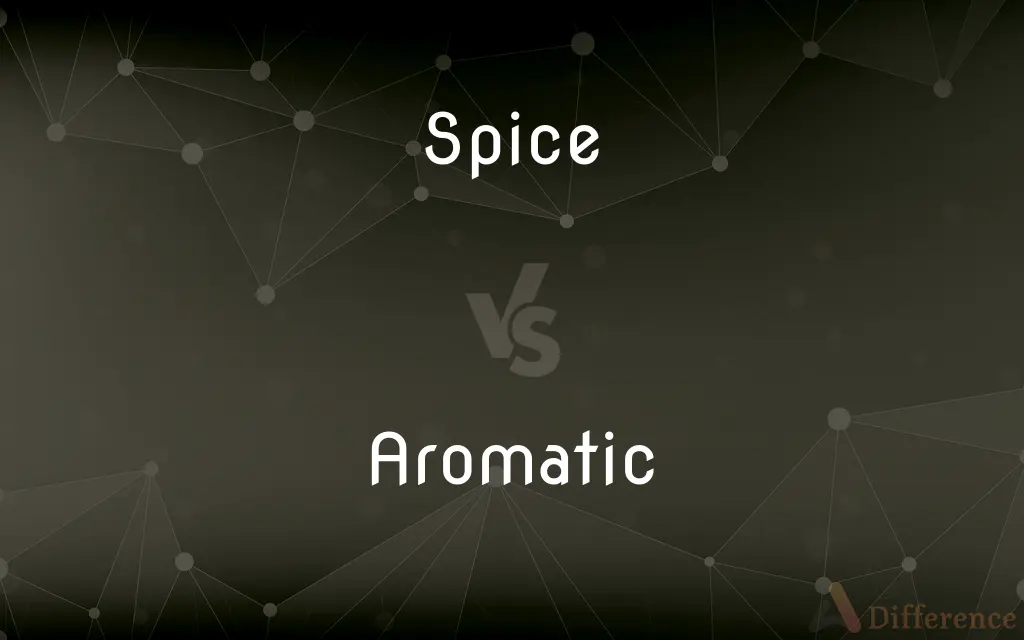Spice vs. Aromatic — What's the Difference?
Edited by Tayyaba Rehman — By Urooj Arif — Updated on March 30, 2024
Spices are dried parts of plants used for flavoring or coloring food, while aromatics are substances known for their fragrance, used in cooking and perfumery.

Difference Between Spice and Aromatic
Table of Contents
ADVERTISEMENT
Key Differences
Spices, such as cinnamon, pepper, and nutmeg, are primarily obtained from dried parts of plants including seeds, berries, bark, and roots, and are used to enhance the flavor and color of food. Aromatics, on the other hand, include a wider range of substances like essential oils, herbs, and spices known for their fragrant properties, used not only in cooking but also in perfumery and aromatherapy.
While spices are celebrated for their ability to add depth and complexity to dishes, aromatics are valued for their scent and potential health benefits. Aromatics like lavender and rosemary are often used in essential oil form for their therapeutic properties, whereas spices are typically used in their solid form.
The use of spices in cooking is as much about adding heat or piquancy as it is about flavor, with many spices also possessing preservative qualities. Conversely, aromatics might be used more for their scent than taste, contributing to the ambiance of a space or the aroma of a dish without significantly altering its flavor profile.
Both spices and aromatics play crucial roles in culinary traditions worldwide, but their cultivation and processing differ. Spices often require specific climates and can be labor-intensive to produce, focusing on the extraction of flavorful compounds. Aromatics, while also sometimes requiring specific conditions for optimal growth, encompass a broader category that includes fresh herbs and flowers used for their scent.
Comparison Chart
Definition
Dried parts of plants used for flavoring, coloring food.
Substances known for their fragrance, used in cooking, perfumery, and aromatherapy.
ADVERTISEMENT
Usage
Enhancing flavor and color of food.
Adding fragrance to spaces, dishes, and products; some therapeutic uses.
Form
Mostly solid (powdered, whole).
Can be solid or liquid (essential oils, fresh herbs).
Cultivation and Production
Often requires specific climates; can be labor-intensive.
Can be more varied; includes herbs, flowers, and spices.
Typical Examples
Cinnamon, black pepper, nutmeg.
Lavender, rosemary, eucalyptus.
Compare with Definitions
Spice
A seasoning or flavoring agent made from dried parts of plants.
Cinnamon spice is derived from the bark of trees in the Cinnamomum genus.
Aromatic
Includes essential oils extracted from plants.
Rosemary oil, known for its aromatic properties, is used in aromatherapy.
Spice
Often has antimicrobial and antioxidant properties.
Turmeric, a common spice, is celebrated for its health benefits.
Aromatic
Fresh herbs can also be considered aromatics in cooking.
Basil is an aromatic herb that adds a fresh scent to dishes.
Spice
Integral to the culinary identity of many cultures.
Saffron, a prized spice, is essential in Spanish paella.
Aromatic
A substance valued for its pleasant smell, used in various domains.
Lavender is an aromatic used in both cooking and perfumery.
Spice
Used globally to add heat, flavor, and color to dishes.
Black pepper is a versatile spice added to recipes around the world.
Aromatic
Influences mood and atmosphere through scent.
Eucalyptus aromatics are used in spas for their relaxing fragrance.
Spice
Can be whole or ground, depending on the application.
Whole nutmeg is grated fresh as needed to preserve its flavor.
Aromatic
Used medicinally for therapeutic benefits.
Peppermint aromatic is utilized for its digestive and soothing properties.
Spice
A spice is a seed, fruit, root, bark, or other plant substance primarily used for flavoring or coloring food. Spices are distinguished from herbs, which are the leaves, flowers, or stems of plants used for flavoring or as a garnish.
Aromatic
Having an aroma; fragrant or sweet-smelling
Aromatic herbs.
Spice
An aromatic or pungent vegetable substance used to flavour food, e.g. cloves, pepper, or cumin
The cake is packed with spices
Sift together flour, baking powder, and mixed spice
Aromatic
(Chemistry) Of, relating to, or containing one or more molecular ring structures having properties of stability and reactivity characteristic of benzene.
Spice
A russet or ginger colour.
Aromatic
An aromatic plant or substance, such as a medication.
Spice
Sweets; confectionery.
Aromatic
(Chemistry) An aromatic organic compound.
Spice
A type of synthetic cannabis
He was smoking spice to cope with his anxiety
Aromatic
Fragrant or spicy.
Aromatic herbs
Aromatic taste
Spice
Flavour with spice
Turbot with a spiced sauce
Aromatic
(organic chemistry) Having a closed ring of alternate single and double bonds with delocalized electrons.
Spice
Any of various pungent, aromatic plant substances, such as cinnamon or nutmeg, used to flavor foods or beverages.
Aromatic
(organic chemistry) Derived from benzene.
Spice
These substances considered as a group.
Aromatic
A fragrant plant or spice added to a dish to flavour it.
Spice
Something that adds zest or interest
The controversy added spice to the political campaign.
Aromatic
(organic compound) Any aromatic compound.
Spice
A pungent aroma.
Aromatic
Pertaining to, or containing, aroma; fragrant; spicy; strong-scented; odoriferous; as, aromatic balsam.
Spice
To season with spices.
Aromatic
A plant, drug, or medicine, characterized by a fragrant smell, and usually by a warm, pungent taste, as ginger, cinnamon, spices.
Spice
To add zest or interest to
Uses witty rhymes to spice up the song.
Aromatic
(chemistry) of or relating to or containing one or more benzene rings;
An aromatic organic compound
Spice
Aromatic or pungent plant matter (usually dried) used to season or flavour food.
Aromatic
Having a strong distinctive fragrance;
The pine woods were more redolent
Spice
(uncountable) The quality of being spicy.
What spice level do you want for your pad thai? I recommend mild.
Spice
Appeal, interest; an attribute that makes something appealing, interesting, or engaging.
Variety is the spice of life
Spice
(uncountable) A synthetic cannabinoid drug.
Spice
Sweets, candy.
Spice
(obsolete) Species; kind.
Spice
A characteristic touch or taste; smack; flavour.
Spice
An aromatic odour.
Spice
(transitive) To add spice or spices to; season.
Spice
(transitive) To spice up.
Spice
Species; kind.
The spices of penance ben three.
Abstain you from all evil spice.
Justice, although it be but one entire virtue, yet is described in two kinds of spices. The one is named justice distributive, the other is called commutative.
Spice
A vegetable production of many kinds, fragrant or aromatic and pungent to the taste, as pepper, cinnamon, nutmeg, mace, allspice, ginger, cloves, etc., which are used in cookery and to flavor sauces, pickles, etc.
Hast thou aught in thy purse [bag] any hot spices?
Spice
Figuratively, that which enriches or alters the quality of a thing in a small degree, as spice alters the taste of food; that which gives zest or pungency; a slight flavoring; a relish; hence, a small quantity or admixture; a sprinkling; as, a spice of mischief.
So much of the will, with a spice of the willful.
Spice
To season with spice, or as with spice; to mix aromatic or pungent substances with; to flavor; to season; as, to spice wine; to spice one's words with wit.
She 'll receive thee, but will spice thy breadWith flowery poisons.
Spice
To fill or impregnate with the odor of spices.
In the spiced Indian air, by night.
Spice
To render nice or dainty; hence, to render scrupulous.
Spice
Aromatic substances of vegetable origin used as a preservative
Spice
Any of a variety of pungent aromatic vegetable substances used for flavoring food
Spice
The property of being seasoned with spice and so highly flavored
Spice
Make more interesting or flavorful;
Spice up the evening by inviting a belly dancer
Spice
Add herbs or spices to
Common Curiosities
Can a spice be an aromatic?
Yes, many spices are also considered aromatics due to their fragrant properties, like cinnamon and clove.
Are essential oils considered spices?
No, essential oils are considered aromatics; they are concentrated liquids containing volatile aroma compounds from plants.
How are aromatics used in cooking?
Aromatics are used to impart fragrance to dishes, often through herbs, spices, and essential oils.
What makes a spice different from an aromatic?
Spices are specifically dried plant parts used for flavoring food, while aromatics are broadly any fragrant substance used for scent, flavor, or therapy.
What are the health benefits of using spices and aromatics?
Both can have health benefits; spices might offer antioxidant properties, while aromatics can have therapeutic effects.
Can aromatics be used for cleaning?
Yes, certain aromatics like lemon and eucalyptus essential oils are used in natural cleaning products for their scent and antimicrobial properties.
Is it possible to be allergic to spices or aromatics?
Yes, individuals can have allergies or sensitivities to specific spices or aromatic compounds.
Do spices lose their flavor over time?
Yes, spices can lose their potency and flavor if not stored properly or kept for too long.
Do all cultures use spices and aromatics in cooking?
Yes, virtually all culinary traditions incorporate some form of spices and/or aromatics, though the specific ingredients and uses vary widely.
What is the most expensive spice, and is it also an aromatic?
Saffron is often cited as the most expensive spice, and it is also valued for its aromatic qualities.
How do spices affect food preservation?
Some spices have antimicrobial properties that can extend the shelf life of foods.
What's the role of aromatics in perfumery?
Aromatics are essential in creating perfumes, providing the distinctive scents that define each fragrance.
How do you store spices and aromatics?
Spices should be stored in a cool, dark place to retain their flavor, while aromatics, especially essential oils, should be kept in dark, airtight containers.
Can aromatics be grown at home?
Many aromatics, especially herbs, can be easily grown in home gardens or indoors.
Are there sustainable practices for producing spices and aromatics?
Sustainable practices include organic farming, fair trade sourcing, and conservation efforts to ensure the longevity of spice and aromatic plant species.
Share Your Discovery

Previous Comparison
Salad vs. Sandwich
Next Comparison
Unadorned vs. UnembroideredAuthor Spotlight
Written by
Urooj ArifUrooj is a skilled content writer at Ask Difference, known for her exceptional ability to simplify complex topics into engaging and informative content. With a passion for research and a flair for clear, concise writing, she consistently delivers articles that resonate with our diverse audience.
Edited by
Tayyaba RehmanTayyaba Rehman is a distinguished writer, currently serving as a primary contributor to askdifference.com. As a researcher in semantics and etymology, Tayyaba's passion for the complexity of languages and their distinctions has found a perfect home on the platform. Tayyaba delves into the intricacies of language, distinguishing between commonly confused words and phrases, thereby providing clarity for readers worldwide.














































